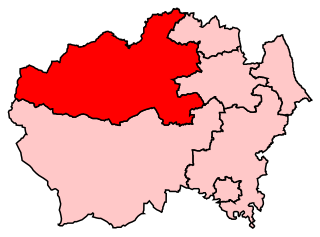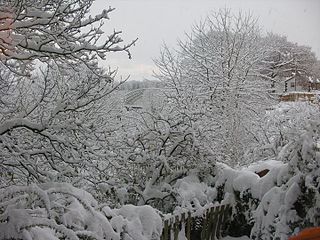
Derwentside was, from 1974 to 2009, a local government district in County Durham, England.

Consett is a town in County Durham, England, about 14 miles (23 km) south-west of Newcastle upon Tyne. It had a population of 27,394 in 2001 and an estimate of 25,812 in 2019.

Stanley is a former colliery town and civil parish in County Durham, North East England. Centred on a hilltop between Chester-le-Street and Consett, the town lies south west of Gateshead.

Crook is a market town in the district and ceremonial county of County Durham, Northern England. The town is located on the edge of Weardale, therefore is sometimes referred to as the "Gateway to Weardale".
Burnopfield is a village in County Durham, in England. It is situated north of Stanley and Annfield Plain, close to the River Derwent and is 564 feet above sea level. There are around 4,553 inhabitants in Burnopfield. It is located 7 miles from Newcastle upon Tyne and 15 miles from Durham.
Edmundbyers is a village in County Durham, in England. It is situated a few miles to the west of Consett, near Derwent Reservoir. In 2001 it had a population of 118. The civil parish of Edmondbyers had a population taken at the 2011 Census of 173. Today, the village has a pub, a youth hostel, a church, a village hall and a small shop. A bus service, the 773, serves the village, connecting it to Townfield, Hunstanworth and Consett.
Wolsingham is a market town in Weardale, County Durham, England. It is situated by the River Wear, between Crook and Stanhope.

Hunstanworth is a small village in County Durham, England. It is situated approximately 10 miles to the west of Consett, south-west of the village of Blanchland. The population of the village as taken at the 2011 Census was 116.

Langley Park is a village in County Durham, England. The historic city of Durham lies 4 miles (6.4 km) to the east, and the larger city of Newcastle upon Tyne is 15 miles (24 km) to the north.

Stanhope is a market town and civil parish in the County Durham district, in the ceremonial county of Durham, England. It lies on the River Wear between Eastgate and Frosterley, in the north-east of Weardale. The main A689 road over the Pennines is crossed by the B6278 between Barnard Castle and Shotley Bridge. In 2001 Stanhope had a population of 1,633, in 2019 an estimate of 1,627, and a figure of 1,602 in the 2011 census for the ONS built-up-area which includes Crawleyside. In 2011 the parish population was 4,581.

North West Durham is a constituency represented in the House of Commons of the UK Parliament since 12 December 2019 by Richard Holden of the Conservative Party.

Lanchester is a village and civil parish in County Durham, England, 8 miles (13 km) west of Durham and 5 miles (8 km) from Consett. It had a population at the 2011 Census of 4,054.
Bilton is a hamlet in Northumberland, in England. It is situated near the River Aln, a short distance inland from the North Sea coast, close to Alnmouth. Alnwick is the nearest town.

Delves Lane is a small village to the south of Consett, County Durham, England. The housing in the area was built as a suburb of Consett, historically providing housing for people working in the former mining and steel industries. The village has one pub: 'The Traveller's Rest'.
Byermoor is a village near Burnopfield and Sunniside in England. The village has a population of around 100 and contains a school and a church. The village sits on the South side of the A692 on a ridge overlooking the Derwent Valley and the nearby village of Burnopfield. It lies just within the County of Tyne and Wear and is the last village on the old turnpike road to Wolsingham before it reaches the border with County Durham.

Hagg Bank or The Hagg is a small Northumberland enclave on the south bank of the River Tyne linked to Wylam by the Points Bridge. It consists of approximately 25 originally two-up, two-down brick terraces, built for housing railway and colliery workers at the turn of the 20th century, which have mostly been extended.











